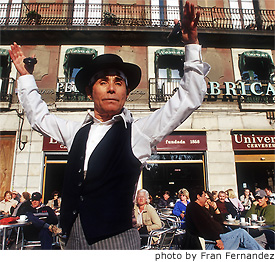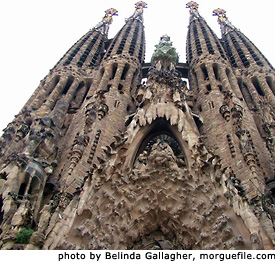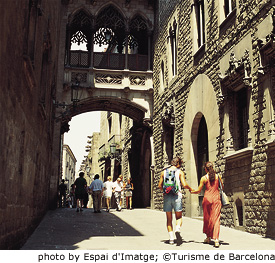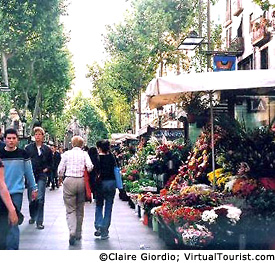Dragon's Blood and Books:
A Spring Festival in Barcelona
by Barbara Wysocki Every April 23 the streets of Barcelona fill with red roses and Shakespeare as the proud Catalans celebrate the feast of their patron, Sant Jordi. Why does the Mediterranean city that inspired Picasso and the famed Spanish architect Gaudi overflow with flowers and books? When spring is at its full power, the Barcelonans and visitors head outside to celebrate a cultural festival that merges a noble dragonslayer with the deaths of two literary lions. The day also offers a potpourri of bookish events and the chance to dance like a Catalan.
Every April 23 the streets of Barcelona fill with red roses and Shakespeare as the proud Catalans celebrate the feast of their patron, Sant Jordi. Why does the Mediterranean city that inspired Picasso and the famed Spanish architect Gaudi overflow with flowers and books? When spring is at its full power, the Barcelonans and visitors head outside to celebrate a cultural festival that merges a noble dragonslayer with the deaths of two literary lions. The day also offers a potpourri of bookish events and the chance to dance like a Catalan.
The legendary Sant Jordi, translate that Saint George, got the rose tradition started when blood splattered by one of his defeated fire-breathing foes sprouted into a rosebush. The story says that the chivalrous saint then bestowed a sanguine blossom on his recently rescued princess. While many around the world give roses on Saint Valentine's Day, in Barcelona they've been exchanging them on April 23 since the 15th century. Today dragon rescue is rarely required so 21st century men retain their hero status by buying 6 million long-stemmed beauties in one day. It's a rare señora or señorita who strolls Barcelona's Las Ramblas or Passeig de Gracia without a bouquet. Sant Jordi's Day isn't an official holiday, but the couples and families walking arm in arm on these wide avenues don't look like they're headed to work.
Just steps from every flower stall, booksellers line those famous shopping streets, hug narrow passageways and dot the city squares such as Placa de Catalonia and Placa Nova. More than 300 bookstalls, festooned with the red and yellow of the Catalan flag, are honoring Miguel de Cervantes and William Shakespeare. Though both authors penned immortal words, they died on the same day, April 23, 1616. It's been more than 400 years since the publication of Don Quixote -- portions of that classic are set in Barcelona.
For these ambling readers, choosing from overwhelming hardcover and paperback options may be the most strenuous challenge. Not every book is great literature, but since this vernal fiesta is also known as The Day of Lovers, women shop for the perfect books for the men they love.  UNESCO has designated April 23 as International Book Day and local officials estimate 400,000 books will be purchased in Barcelona on this day; so there's a lot for booksellers and book buyers to love. Mysteries, cooking, meditation, how-to and fiction for young and old are among the carefully wrapped packages carried home before the petal-strewn streets are empty.
UNESCO has designated April 23 as International Book Day and local officials estimate 400,000 books will be purchased in Barcelona on this day; so there's a lot for booksellers and book buyers to love. Mysteries, cooking, meditation, how-to and fiction for young and old are among the carefully wrapped packages carried home before the petal-strewn streets are empty.
Especially prized are the Catalan-language volumes. The region's native tongue has undergone periods of neglect and suppression. From 1939 until the early 1950's, the Franco regime forbade the printing of books, magazines or newspapers in Catalan, according to Thomas Harrington of Trinity College in Hartford, Connecticut.
The people of Catalonia, located in the northeast corner of Spain, view themselves as a "cultural nation," adds the associate professor of modern languages and literature. It's ironic that in the 1920's when Barcelona publisher Vincente Clavel proposed a day to honor books, he focused on Cervantes, a Castilian writer. It wasn't until 1926, that books were honored on the same day as Catalonia's patron saint.
During the decades when their language and customs were suppressed, the Barcelonans embraced Sant Jordi's Day with extra vigor. Nowadays with spring flowers and street performers in abundance, book browsers from all nations feel at home in the city. In addition to the open-air bookstalls, local publishers and bookstores host authors and illustrators, many of them available to autograph their work. If autographs aren't sufficient inducement, most buyers will be lured by discount prices.
For a complete listing of concerts, exhibitions and lectures, check at Barcelona's main tourist office downstairs in the southeast corner of Placa de Catalonia. Register there for walking tours that highlight the history and architecture of Picasso's old haunts, and the even older haunts of the Gothic Quarter.  Prefer to be your own guide? Search the booksellers for the English language title, Walks Through Literary Barcelona. Published in 2005, the volume points visitors to the city's literary past.
Prefer to be your own guide? Search the booksellers for the English language title, Walks Through Literary Barcelona. Published in 2005, the volume points visitors to the city's literary past.
It's wise to save those walks for a day when the streets are not so full. Marta Balletebo-Col, a filmmaker and Catalan native warns, "The crowds might make you dizzy and it almost always rains."
Rain or shine, it's a short walk down the Avenue del Porta de L'Angel that begins at Placa de Catalonia. Along the way there's a delectable mix of cafés and chocolatiers. This is a pace-yourself kind of day so there's plenty of time to enjoy a coffee and listen to a dark-haired youth, all fluid grace as he plucks his harp. Stop by the blues guitarist who's staked out an alley and don't bypass a barrel-chested tenor on the steps of the Archdeacon's House. He often moves his audience to tears.
From there it's two steps up into the chapel of Santa Lucia, then a turn around the Cathedral of Santa Eulalia that dates to the 13th century. It's always soothing to visit the cloister with its chorusing geese.
Only consult your watch to be sure you arrive in the Placa Sant Jaume by early evening. All the other music fades away as prosperous-looking matrons and dignified men greet each other in the historic square. Though the air is too perfumed with roses, they could be assembled in an elegant drawing room. Instead, they are sandwiched between Barcleona's City Hall and the Palace of the Generalitat, a pleasing mix of Gothic and Renaissance architecture.
Under the watchful gaze of the statue of Sant Jordi, a small band, or cobla, climbs onto the temporary stage. The crowd quiets. It is time for the Sardana, the folk dance that defines Catalonia.
The first notes come from the flaviol, a tiny high-pitched flute. Then the brass begins. Finally the strings connect the haunting melody.  Spontaneously, men and women in the crowd join hands and circles form. They pile jackets, purses and shopping bags in the center as the human circumference grows. Their step is light, deliberate and utterly joyful. No one is a bystander here; those who do not dance begin to sing softly.
Spontaneously, men and women in the crowd join hands and circles form. They pile jackets, purses and shopping bags in the center as the human circumference grows. Their step is light, deliberate and utterly joyful. No one is a bystander here; those who do not dance begin to sing softly.
Beneath the music and movement, the oblong stones that rest where Barcelona's Roman forum once stood now join the past and present. Faces alight with pride and pleasure, the dancers move to left and right. They raise their hands high in homage to Sant Jordi and the proud people of Catalonia.
For more information, see these websites http://www.spain.info, and http://www.barcelona turisme.com (click on the English icon if needed); e-mail teltur@barcelona turisme.com or nuevayork@tourspain.es; or telephone (212) 265-8822.

